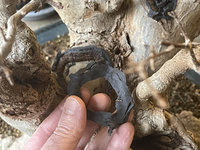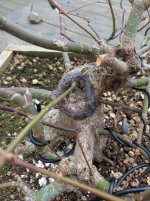You are using an out of date browser. It may not display this or other websites correctly.
You should upgrade or use an alternative browser.
You should upgrade or use an alternative browser.
CLOSING WOUNDS
- Thread starter MACH5
- Start date
leatherback
The Treedeemer
MACH5
Imperial Masterpiece
Also, I just remembered that I did same technique on a few very large scars (4"+) on Piglet and will post pics of them.
Want to mention for those less experienced. If you have larger wounds you do not have to resort to this technique necessarily. The tree (specially fast growing species such as acer) can/will heal them with no issues. It is ONLY meant if the wood underneath is rotted that this technique is very useful and effective.
Want to mention for those less experienced. If you have larger wounds you do not have to resort to this technique necessarily. The tree (specially fast growing species such as acer) can/will heal them with no issues. It is ONLY meant if the wood underneath is rotted that this technique is very useful and effective.
leatherback
The Treedeemer
Thx. I was mostly interested in seeing how much closing you had in the first season, and whether it took off after that. I am editing a video I did on this technique, where the edges are not closing as much as I would have liked:Also, I just remembered that I did same technique on a few very large scars (4"+) on Piglet and will post pics of them.

SeanS
Omono
- Messages
- 1,644
- Reaction score
- 5,559
- USDA Zone
- 9b
@leatherback I think some tridents just close wounds better than others. I’ve got some tridents that are closing large wounds amazingly fast, with thick healthy callous. Others are much slower and produce very thin callous which almost seems to dry up in sections and stop moving all together.Thx. I was mostly interested in seeing how much closing you had in the first season, and whether it took off after that. I am editing a video I did on this technique, where the edges are not closing as much as I would have liked:
View attachment 522608
MACH5
Imperial Masterpiece
Thx. I was mostly interested in seeing how much closing you had in the first season, and whether it took off after that. I am editing a video I did on this technique, where the edges are not closing as much as I would have liked:
View attachment 522608
Jelle, have you also tried scarring the edge of the callous to encourage it to keep rolling?
leatherback
The Treedeemer
Absolutely!Jelle, have you also tried scarring the edge of the callous to encourage it to keep rolling?
It is however a very old wound, with loads of soft wood and I had to carve deel to get to the end of rotting wood. It could just be that it needs to pick up strength in that area.
MACH5
Imperial Masterpiece
Absolutely!
It is however a very old wound, with loads of soft wood and I had to carve deel to get to the end of rotting wood. It could just be that it needs to pick up strength in that area.
Yes, quite possibly. Of course I will also assume that you know that to close wounds faster the tree needs to be growing vigorously. I know with you I am probably stating the obvious but this comment is really meant for others that are perhaps less experienced.
leatherback
The Treedeemer
MACH5
Imperial Masterpiece
Oh ya! I am surprised the callousing is not moving faster for you. But give it time and I am sure it will close up, especially with tridents!
MACH5
Imperial Masterpiece
Here is one large scar on Piglet. For those not familiar with it here is the thread: https://www.bonsainut.com/threads/piglet-chapter-2.37719/
Originally Judy had carved these large wounds to leave them as deadwood or at least that is my assumption. The carving work was nicely done but ultimately decided to go ahead clean the area out, fill it with two part epoxy and have it close nice and even. This work was done in spring 2023.
Below is one of three large scars that I am in the process of healing. This one is 3.5" round. In this first photo you can see the cut paste evenly cracking around the perimeter of the wound. This is always a good sign that the callous is rolling well.

In this second photo I am removing the callous which at this point it came off easily and in one piece.

Afterwards one can see clearly the callous rolling evenly throughout. Total expected time before closing about 3 years.

Originally Judy had carved these large wounds to leave them as deadwood or at least that is my assumption. The carving work was nicely done but ultimately decided to go ahead clean the area out, fill it with two part epoxy and have it close nice and even. This work was done in spring 2023.
Below is one of three large scars that I am in the process of healing. This one is 3.5" round. In this first photo you can see the cut paste evenly cracking around the perimeter of the wound. This is always a good sign that the callous is rolling well.

In this second photo I am removing the callous which at this point it came off easily and in one piece.

Afterwards one can see clearly the callous rolling evenly throughout. Total expected time before closing about 3 years.

Last edited:
leatherback
The Treedeemer
One of the most satisfying images in Bonsai I always find!In this first photo you can see the cut paste evenly cracking around the perimeter of the wound
MACH5
Imperial Masterpiece
A little correction as I read back my last post. In the second photo description I meant removing the cut paste and not the callous! Sorry too much holiday drinking! 
Not sure why it is not possible to edit our posts after a 20 mins
Not sure why it is not possible to edit our posts after a 20 mins
leatherback
The Treedeemer
To stop streetfights between editing authors and attacking posters.Not sure why it is not possible to edit our posts after a 20 mins
MACH5
Imperial Masterpiece
To stop streetfights between editing authors and attacking posters.
@MACH5 / all. Did you do any experimentation with the timing of re-opening the wounds to make them heal better?
I mean, January compared to when buds move
I used Loctite repair putty a couple of years ago and it has completely broken down so I had to remove it. Will try some other brand this year
I mean, January compared to when buds move
I used Loctite repair putty a couple of years ago and it has completely broken down so I had to remove it. Will try some other brand this year
Attachments
MACH5
Imperial Masterpiece
@MACH5 / all. Did you do any experimentation with the timing of re-opening the wounds to make them heal better?
I mean, January compared to when buds move
I used Loctite repair putty a couple of years ago and it has completely broken down so I had to remove it. Will try some other brand this year
KwikWood has work very well for me.
I don't think it matters at all. The only benefit to doing it say winter time is if you anticipate a very busy spring. So doing it now saves you that time later. The vascular growth does not start until after spring flush when trees then recover their energy. So really you can do it now but you won't see much happening after later in the growing season. Much more important to promote rapid healing is to ensure all cuts are made clean with sharp tools and properly covered with cut paste. The putty kind (gray or brown) I think is the best IMO.
SeanS
Omono
- Messages
- 1,644
- Reaction score
- 5,559
- USDA Zone
- 9b
Agreed, I don’t think it matters. I might scrape/rough up callous around a wound a few times per season, whenever I think the healing is slowing down@MACH5 / all. Did you do any experimentation with the timing of re-opening the wounds to make them heal better?
I mean, January compared to when buds move
I used Loctite repair putty a couple of years ago and it has completely broken down so I had to remove it. Will try some other brand this year
MACH5
Imperial Masterpiece
Similar threads
- Replies
- 11
- Views
- 1K




